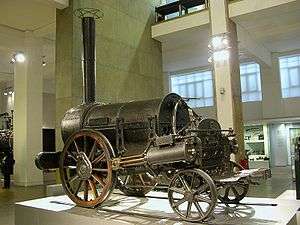0-2-2

An 0-2-2, in the Whyte notation for the classification of steam locomotives by wheel arrangement, is one that has two coupled driving wheels followed by two trailing wheels, with no leading wheels. The configuration was briefly built by Robert Stephenson and Company for the Liverpool and Manchester Railway
Equivalent classifications
Other equivalent classifications are:
- UIC classification: A1 (also known as German classification and Italian classification)
- French classification: 011
- Turkish classification: 12
- Swiss classification: 1/2
Overview
The 0-2-2 or Northumbrian wheel arrangement appears to have been first used on locomotives taking part in the Rainhill Trials of 1829. John Ericsson and John Braithwaite's Novelty, was an 0-2-2 well tank locomotive although both the driving wheels and trailing wheels were the same size.[1] However, the most famous 0-2-2 was Stephenson's Rocket, which was the only locomotive to complete the trials successfully.
.jpg)
The type was subsequently used by Robert Stephenson and Company on eight locomotives supplied to the Liverpool and Manchester Railway after 1829:, Meteor, Comet, Dart, Arrow, Phoenix, North Star, Northumbrian, and Majestic. However, the type quickly became superseded by the 2-2-0 Planet types which permitted inside cylinders and so were less prone to oscillation at speed, and then 2-2-2 Single configurations as locomotives grew larger.
In the early 20th Century a number of railmotors were built by various railway companies in the UK where the locomotive section had an 0-2-2 wheel arrangement, but they were designed to operate semi-permanently coupled to a coach unit.
References
- ↑ The Science Museum, The British Railway Locomotive 1803-1853, H.M.S.O. 1958. pp.5-6.